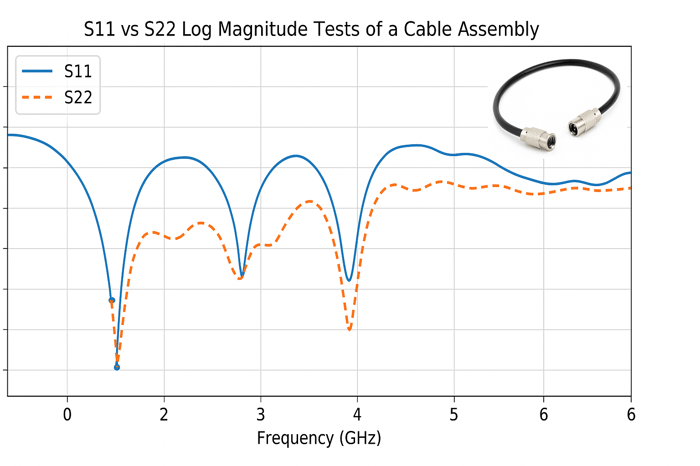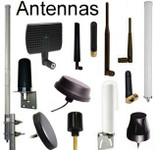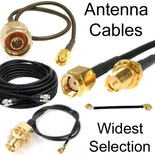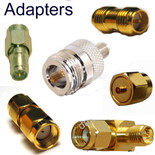Antennas, Antenna Cables, Wireless Products: Technical Articles
S11 vs S22 Log Magnitude Tests of a Cable Assembly
Table of Contents
- Understanding S11 and S22 (Reflection Parameters at Each Port)
- Log Magnitude and Return Loss in S-Parameter Tests
- S11 vs S22: Return Loss at Port 1 vs Port 2
- Symmetry vs. Asymmetry in Cable Assembly Performance
- Connector Matching and Assembly Quality Considerations
- Practical Implications of S11 vs S22 Results
- In summary
- FAQs
Understanding S11 and S22 (Reflection Parameters at Each Port)

In a two-port RF network (like a cable assembly), S11 and S22 are the reflection S-parameters at port 1 and port 2, respectively. They quantify how much of an incident signal is reflected back at the input of each port due to impedance mismatch. In practical terms, S11 measures the return loss looking into port 1 (with port 2 terminated in 50 Ω), while S22 measures the return loss looking into port 2. Both S11 and S22 reveal the impedance matching at their respective ends – essentially indicating what fraction of the signal bounces back from each port instead of traveling through. A well-matched port has a small reflection (low |S11| or |S22|), whereas a poorly matched port reflects a larger portion of the signal.
Log Magnitude and Return Loss in S-Parameter Tests
When examining S-parameters, engineers typically view the results in log magnitude (dB) form. The log magnitude (sometimes labeled “LogM” on network analyzers) is simply 20·log10(|S|) in decibels. Expressing S11 or S22 in dB makes it easier to interpret small reflections on a wide dynamic range. This log magnitude is essentially the return loss when dealing with reflection coefficients. A more negative dB value for S11 or S22 indicates a smaller reflected signal (thus a better match). For example, an S11 of –20 dB means only about 1% of the power is reflected (99% goes through), whereas –10 dB corresponds to ~10% reflection. In other words, higher return loss (in dB) = lower reflection, which is desired. Measuring S11 or S22 in log scale allows technicians to quickly see how well the cable’s ends are matched: each additional –6 dB of return loss means the reflected power is cut to one-quarter (since power is on a logarithmic scale).
S11 vs S22: Return Loss at Port 1 vs Port 2
S11 (LogM)
- Specifically tests port 1’s reflection behavior. In practice, to measure S11 of the cable assembly, port 1 of the VNA is connected to one SMP-female end of the cable, and the other end (port 2) is terminated in a known 50 Ω load (often the VNA’s port 2 during a two-port measurement). The S11 reading (in dB) tells us how much signal is reflected back into port 1 versus delivered into the cable. This is effectively the return loss looking into that end of the assembly, encompassing the connector and any discontinuity near port 1. Likewise,
S22 (LogM)
- Is the reflection seen looking into port 2 of the assembly. When measuring S22, the roles are reversed: port 2 is driven and port 1 is the termination. S22 in dB indicates how much of port 2’s incident signal is reflected back toward port 2. In other words, S22 gauges the return loss at the opposite end of the cable (the second SMP-female connector). Together, these two measurements isolate the performance of each end: S11 reveals reflections at the port 1 end, and S22 reveals reflections at the port 2 end. If one end of the cable assembly is less well matched (for example, due to a connector issue or assembly flaw), the corresponding S-parameter (S11 or S22) will show a higher reflection (a less negative dB value) for that end.
Symmetry vs. Asymmetry in Cable Assembly Performance
Example S-parameter plots of a coaxial cable assembly (magnitude vs. frequency up to 40 GHz). S11 (top-left) and S22 (bottom-right) both indicate good return loss overall, but a distinct resonance in the S22 curve (~18 GHz) is absent in S11 – highlighting an asymmetry or specific mismatch at port 2.
An ideal coaxial cable assembly is a reciprocal passive network, so we expect it to behave symmetrically from either end. In fact, for a perfect, lossless cable with identical connectors, the reflections at both ends would be the same (S11 = S22 in magnitude). In real-world assemblies, if the construction is truly symmetric and both SMP-female connectors are identical and properly installed, S11 and S22 should be nearly identical traces across frequency. Any significant difference between the S11 and S22 return loss indicates the system is not perfectly symmetrical.
Small S11 vs S22 discrepancies are common and usually traceable to minor physical differences at the two ends. For example, manufacturing tolerances or assembly processes might cause one connector to have a slightly different pin depth or dielectric interface. Even if the cable and connectors are nominally the same, one end could have a subtle impedance bump that the other end does not. Asymmetry in the cable assembly – whether due to a different connector style, a bend in one end, or a slight assembly imperfection – will manifest as S11 ≠ S22. In the example plots above, a pronounced notch (high return loss dip) around 18 GHz appears in S22 but not in S11, signifying a resonance or mismatch specific to the port 2 side. In a truly symmetrical assembly, such a feature would appear identically in both S11 and S22 (or not at all). Thus, engineers interpret differences between S11 and S22 as a diagnostic clue: the end with the poorer return loss or anomalous frequency response is likely the side with a connector or construction issue.
Connector Matching and Assembly Quality Considerations
Connector matching and overall assembly quality directly affect S11 and S22 results. An SMP-female connector (like any RF connector) has an internal geometry that needs to transition smoothly from the cable’s 50 Ω coax to the connector interface. If that transition is well-designed and properly assembled, the connector will present a near-50 Ω load to incoming signals, yielding a low reflection (high return loss). High-quality SMP connectors are designed for excellent impedance continuity – for example, straight SMP cable connectors can achieve on the order of 23 dB return loss up to 20 GHz. This means each connector itself reflects very little of the signal when properly mated to a 50 Ω system.
However, assembly imperfections can undermine that matching. In a 4-inch cable assembly, the short length means most of the return loss issues stem from the connectors and how they’re attached. If one SMP female connector isn’t installed with the same precision as the other, its mating interface might have a tiny air gap, misaligned dielectric, or slightly protruding center conductor. These small physical differences create impedance discontinuities that reflect energy. For instance, a slight gap or excess solder in the connector can introduce a capacitive or inductive bump, causing higher reflection at certain frequencies. The result would be that the S-parameter for that end (S11 or S22) shows worse return loss or maybe a notch/dip at a particular frequency (as in the earlier example). In contrast, the opposite end – if assembled correctly – would show a smoother response with lower reflections.
Because SMP connectors operate at very high frequencies (up to ~40 GHz for standard SMP), even very minute variances (fractions of a millimeter in pin position or dielectric spacing) can affect the return loss. A symmetric assembly requires consistent connector quality on both ends: same connector type, same assembly process, proper torque and soldering, etc. In practice, RF technicians pay close attention to connector attachment – trimming the cable precisely, ensuring the dielectric is flush, and that the connector is fully seated. Good assembly practice will produce S11 and S22 that are both low (e.g. better than –20 dB) and closely matched to each other. Conversely, if S11 vs S22 differ by a large margin (e.g. one end is 10 dB worse), it’s often a sign of an assembly issue like a mis-crimped ferrule, bad solder joint, or even a damaged connector on the poorer-performing end.
Practical Implications of S11 vs S22 Results
Differences in S11 and S22 have practical consequences for both testing and use of the cable assembly. In an ideal scenario, a cable assembly should perform equally well regardless of which end is connected to the source or load. If S11 and S22 are both high (e.g. –20 dB or better) and roughly equal, the cable can be used in either orientation confidently – both SMP ends are well-matched, minimizing reflections into connected equipment. This indicates good connector matches and overall assembly quality, so the cable will transfer power efficiently and predictably in real applications.
On the other hand, if one port shows poorer return loss than the other, the cable assembly effectively has a “weak end.” For example, suppose S11 is –25 dB (excellent) but S22 is only –12 dB. In use, the port 2 end (with –12 dB return loss) will reflect about 6% of the power back at the source (since –12 dB ≈ 6% reflected), compared to only ~0.3% reflected at the port 1 end (–25 dB). This has a few implications:
Connector Mismatch:
- The device or instrument connected to the worse end (port 2 in this case) will see a significant impedance mismatch. If that end connects to, say, a transmitter or a sensitive measurement port, the higher reflection could distort the measurement or even stress the source (high VSWR can cause higher voltage on transmitter outputs). Thus, one might preferentially connect the better-matched end to critical equipment to reduce potential issues, though ideally the cable should be fixed or replaced. As one RF engineer put it, the goal is to make both S11 and S22 “as low as practical” (meaning reflections as small as possible) because any reflected power is essentially wasted and can interfere.
Assembly Quality Control:
- A notable S11 vs S22 difference alerts the technician to inspect the cable. It might prompt re-measuring after re-terminating the bad end or tightening the connector interface. In manufacturing, return loss tests on both ends are often part of QA for precisely this reason – to catch a situation where, for example, one connector wasn’t soldered correctly or a pin depth is out of spec. The practical upshot is that each port’s performance must meet the spec for the assembly to be considered good. If port 2 shows –12 dB when the spec is, say, ≤ –15 dB, the assembly would likely be rejected or reworked even if port 1 was fine.
Port Performance in Systems:
- If a cable with an asymmetrical match must be used, system designers might account for it. For instance, the port with higher reflection could be connected to a port that has an isolator or a attenuator pad after it, to buffer the reflection. In test setups, one might calibrate the VNA with the cable in place; the calibration can mathematically null out some cable effects, but a strong mismatch can still re-reflect between the cable and DUT and introduce ripple. Therefore, a high return loss (low reflection) at both ends is especially important for precision measurements (to avoid measurement uncertainty due to multiple reflections).
In summary
S11 vs S22 results guide both troubleshooting and usage: A discrepancy points to a connector or build issue on the poorer side, and in the field it means that side will cause more reflection-related issues. The best practice is to ensure both ends of an RF cable assembly have excellent return loss so that the cable does not become the limiting factor in system performance.
FAQs
What do S11 and S22 represent in a two-port RF network?
S11 is the reflection parameter at port 1, and S22 is the reflection parameter at port 2. They quantify how much of the incident signal is reflected back due to impedance mismatch at each port.
How are S11 and S22 related to return loss?
S11 and S22 expressed in dB indicate return loss. A more negative value means less reflection and better impedance matching. For example, –20 dB ≈ 1% reflection, while –10 dB ≈ 10% reflection.
Why do engineers use log magnitude (dB) for S-parameters?
Using 20·log10(|S|) in decibels allows engineers to easily see small reflections over a wide dynamic range. Each –6 dB step corresponds to quartering the reflected power, making performance differences easy to interpret.
How do you measure S11 vs S22 in practice?
To measure S11, port 1 of the VNA connects to the DUT’s port 1 while port 2 is terminated in 50 Ω. To measure S22, the roles are reversed: port 2 is driven and port 1 is terminated.
Why might S11 and S22 differ for the same cable assembly?
Ideally, they should be nearly identical. Differences usually stem from asymmetry: connector mismatches, manufacturing tolerances, or slight assembly imperfections such as pin depth variation or solder gaps.
What are the practical consequences of poor S11 or S22 at one end?
A poorly matched end reflects more power, creating higher VSWR and potential issues for transmitters or sensitive measurement equipment. It also reduces efficiency and measurement accuracy in RF systems.
How do connector quality and assembly affect S11 and S22?
High-quality, properly assembled connectors present close to 50 Ω and yield low reflection (e.g., ≤ –20 dB). Poor assembly (mis-crimp, solder gap, air gap, damaged connector) causes impedance discontinuities, visible as degraded S11 or S22.







